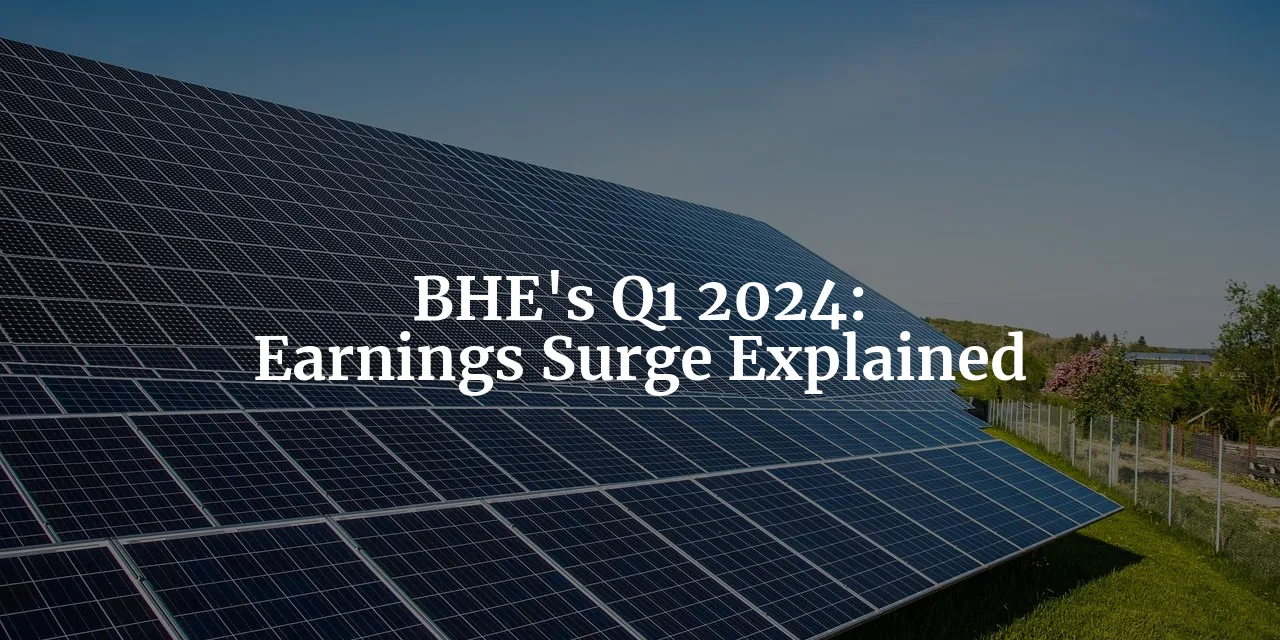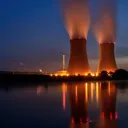Tags: BHE / Earnings
This fanpage is not officially affiliated with Berkshire Hathaway: Disclaimer
Let es dive into the electrifying world of BHE's Q1 2024 earnings surge based on Berkshire Hathaway's quarterly report and the annual shareholder meeting. We look at strategic investments, regulatory landscapes, and renewable energy innovations.

Introduction
In the first quarter of 2024, Berkshire Hathaway Energy (BHE) demonstrated a remarkable performance, marking a significant earnings surge that underscores the company's robust strategic positioning and operational efficiency after a challenging 2023 ↗. This period saw BHE navigating through a complex economic and regulatory environment, yet achieving a notable increase in profitability across its diverse energy portfolio. The acquisition of MidAmerican Energy in 1999 for $2bn was a pivotal moment that solidified Berkshire Hathaway's foray into the energy sector, setting the stage for decades of expansive growth and diversification 5.
This article delves into the financial nuances of BHE's performance in Q1 2024, offering shareholders and interested stakeholders a detailed breakdown of earnings across different sectors within the company. From the regulated utilities in the United States to the renewable energy projects and natural gas pipelines, each segment reflects a unique aspect of BHE's business strategy and market dynamics. Readers can expect a comprehensive analysis of the financial results, contextualized within the broader industry challenges and BHE's strategic responses.
Financial Overview of Q1 2024
The first quarter of 2024 has been a testament to BHE's resilience and strategic foresight, with net earnings significantly outperforming the previous year's figures. Here's a closer look at the financial dynamics that shaped this quarter 1:
| Year | BHE Q1 Net Earnings |
|---|---|
| 2021 | $809m |
| 2022 | $850m |
| 2023 | $472m |
| 2024 | $789m |
The overall net earnings for Q1 2024 stood at $789 million, a substantial rise from $472 million in Q1 2023. This improvement was primarily driven by several key factors:
-
U.S. Utilities Performance: The after-tax earnings of U.S. utilities saw an increase of $213 million compared to the same period in 2023, largely due to lower energy operating expenses and higher other income. This boost reflects BHE's ongoing efforts to optimize operational efficiency and capitalize on favorable market conditions 1. Thus, the Utilities sector saw an increase in electric utility margin by $23 million in Q1 2024 compared to the previous year, primarily due to lower energy operating expenses and higher other income 1. This sector continues to benefit from efficient operational practices and strategic cost management.
-
Interest Expenses: Despite the positive earnings, BHE faced increased interest expenses, which rose by $102 million over the previous year. This uptick was attributed to increased borrowings, underscoring the company's strategic investments in infrastructure and expansion projects amidst a challenging interest rate environment 1.
-
Natural Gas Pipelines and Other Energy Businesses: The natural gas pipelines sector experienced a rise in after-tax earnings by $130 million, benefiting from reduced operating expenses and an increased margin on gas sales. Additionally, other energy businesses, including Northern Powergrid and renewable energy ventures, contributed an extra $99 million in after-tax earnings, highlighting the growing profitability of these segments 1.
-
Real Estate Brokerage Challenges: On the downside, the real estate brokerage arm of BHE witnessed a decline in earnings by $125 million, primarily due to expense accruals related to ongoing litigation. This setback illustrates the volatile nature of the real estate market and the external challenges impacting this sector 1.
-
Furthermore, in the Renewables sector, there was an increase of $22 million in earnings, attributed to higher earnings from the retail energy services business and improvements in geothermal and natural gas earnings 4. The growth in solar and ongoing improvements in geothermal highlight BHE's commitment to expanding its renewable energy portfolio.
Here’s a breakdown of the performance metrics across these sectors from Q1 2023 to Q1 2024, highlighting key changes and drivers 1. Note: earnings are not entirely attributable to Berkshire Hathaway owning 92% of BHE:
| BHE sector | Q1 2024 | Q1 2023 | Change |
|---|---|---|---|
| U.S. utilities | $ 376m | $ 163m | 130.7% |
| Natural gas pipelines | $ 499m | $ 369m | 35.2% |
| Other energy businesses | $ 282m | $ 183m | 54.1% |
| Real estate brokerage | ($ 159m) | ($ 34m) | -367.6% |
| Corporate interest and other | ($ 209m) | ($ 209m) | — |
| Total | $ 789m | $ 472m | 67.2% |
BHE's financial performance illustrates a company leveraging its strengths in traditional and renewable energy markets while navigating challenges in real estate. The strategic importance of each sector to BHE’s overall portfolio is clear, with ongoing investments aimed at enhancing long-term sustainability and capitalizing on global energy trends.
Regulatory and Legislative Landscape
The regulatory and legislative environment is a crucial backdrop against which Berkshire Hathaway Energy (BHE) operates. Recent developments, particularly in Utah, have introduced new dynamics that could significantly influence BHE’s operations and financial performance. The Utah legislature has recently mandated that the state will serve as the sole purchaser of energy from in-state power plants 2. This policy reshapes the market landscape, potentially altering BHE's revenue streams from these assets.
Greg Abel underscored the importance of a regulatory compact between public utilities and states. Such a compact is vital for ensuring that utilities can continue to operate effectively while meeting the evolving demands of both regulators and consumers 2. This compact will likely become increasingly significant as BHE navigates the challenges and opportunities presented by shifting regulatory frameworks.
The model set by Utah in response to wildfire liabilities is particularly noteworthy. The state has implemented a cap on non-economic damages and established a wildfire fund, measures seen as the “gold standard” by BHE 2. These legislative actions could serve as a blueprint for other states in which BHE operates, potentially reducing the company's exposure to wildfire-related risks.
Furthermore, the necessity for legislative and regulatory reform in Pacific Corp states to effectively deploy capital highlights the ongoing need for an adaptive regulatory approach to support substantial investments in utility infrastructure 2 ↗. These reforms are crucial as they could dictate the pace and scale at which BHE can implement its strategic initiatives, especially in light of the increasing frequency and severity of wildfires exacerbated by climate change.
As we can see, the regulatory and legislative landscape is evolving, with significant implications for BHE's strategic decisions and risk management. The company must continue to engage with policymakers to shape regulations that support sustainable growth while managing operational risks effectively.
Strategic Investments and Capital Allocation
In the dynamic landscape of the energy sector, Berkshire Hathaway Energy (BHE) has demonstrated a proactive approach to capital allocation, underpinned by a commitment to long-term strategic investments. Greg Abel emphasized the necessity for "significant investment" in the industry, a sentiment reflecting the forward-thinking ethos of BHE 2.
Major Investments and Future Projections. BHE's investment strategy is robust, particularly in regions like Iowa and Nevada, where future utility demands are projected to surge. In Iowa, demand is expected to double by the mid-2030s, necessitating substantial capital investment to meet this growth 2. Similarly, Nevada's utility demand is forecasted to triple by the late 2030s, presenting both a challenge and an opportunity for strategic growth through significant financial commitment 2.
Historical Context and Strategic Decisions. The strategic decisions to bolster investments in these areas are not made in isolation. They are part of a broader narrative that began in 1999 when Warren Buffett steered Berkshire Hathaway into the energy sector with the acquisition of MidAmerican Energy for $2bn 5. This move marked the beginning of what would become a major component of Berkshire's portfolio. The acquisition of Dominion Energy's natural gas infrastructure in 2020 for $8bn further exemplifies Berkshire's strategic intent to enhance its energy infrastructure amidst evolving market demands 5.
Balancing Infrastructure Needs with Financial Prudence. The strategic investments are carefully balanced with the need to manage financial risks ↗ ↗. This balance is crucial in maintaining a robust infrastructure that can support future energy demands while safeguarding the company's financial health. The approach taken by BHE underscores a deep understanding of the complex interplay between operational capacity and economic viability in the highly regulated energy sector.
Challenges and Risks
The path of strategic investment in the energy sector is fraught with challenges and risks, particularly in the context of climate change and regulatory environments. BHE, like many in the industry, faces significant operational and financial risks.
1. Wildfire Risks and Legislative Actions
Recent years have seen an increase in wildfires, exacerbated by climate change, significantly impacting utility operations. BHE has experienced firsthand the financial repercussions, with a jury ordering its subsidiary, PacifiCorp, to pay $70 million in punitive damages for wildfires in Oregon in 2020 6. In response, states like Utah have enacted legislation to mitigate these risks, setting a cap on non-economic damages and creating a wildfire fund 2. These legislative actions, while helpful, underscore the ongoing financial and operational risks associated with natural disasters.
2. Litigation Risks and Operational Shifts
The litigation risks are compounded by the need for cultural and operational shifts within utility companies. BHE has adapted its operating systems to quickly de-energize assets during fire threats, a necessary change to mitigate risk but one that also reflects the broader industry challenge of balancing service reliability with safety 2.
3. Regulatory and Financial Uncertainties
Warren Buffett has expressed concerns about the future profitability of the utilities business, hinting at the potential for zero profitability or even bankruptcy due to unforeseen regulatory changes or financial surprises 5. This stark outlook highlights the precarious nature of the utility industry in an era of increasing regulatory scrutiny and financial volatility.
4. Shareholder Concerns and Climate Change
Moreover, shareholder concerns, particularly regarding climate change, have prompted calls for more detailed disclosures on climate risks. Despite resistance from Berkshire's leadership, these concerns reflect a growing recognition of the societal risks underwritten by power companies, as noted by Pedro Pizarro of Edison International 5. The demand for transparency and accountability in how utility companies manage and disclose climate-related risks is likely to intensify.
Navigating the complex interplay of investment opportunities, regulatory challenges, and environmental risks, BHE remains committed to its strategic vision. By investing in essential infrastructure and adapting to legislative changes, BHE aims to secure a sustainable and profitable future. However, the journey is lined with significant challenges that require diligent management and strategic foresight.
Future Outlook and Strategic Directions
As Berkshire Hathaway Energy (BHE) looks to the future, the landscape is marked by both significant challenges and transformative opportunities such as the AI revolution ↗. The expected doubling of demand for Iowa's utility services and the tripling in Nevada underscore the strategic importance of these markets 2. These projections not only highlight the growing energy needs but also frame the urgency for robust infrastructure and investment strategies to meet this surge effectively.
Embracing Renewable Energy. The transition from carbon resources to renewable energy sources is pivotal in BHE's strategic outlook ↗. With global warming posing substantial challenges to traditional energy paradigms, BHE is actively transitioning towards more sustainable sources like solar and wind. Greg Abel, poised to lead BHE into this new era, acknowledges that while gas will remain a crucial component for reliability and affordability in the near term, the shift towards renewables like solar and wind is inevitable and beneficial 3. This transition, however, is not without its complexities. As Warren Buffett pointed out, solar energy, despite its potential, faces limitations due to its intermittency and the current inadequacies in storage technology 3.
Innovations in Energy Storage. Addressing the intermittency of renewable sources, innovations in storage technology are critical. The ongoing developments, as highlighted by Bill Gates' efforts to enhance battery storage capabilities, could revolutionize the viability of solar energy 3. These advancements are expected to extend storage times significantly, thereby mitigating one of the primary drawbacks of renewable energy sources. BHE's engagement in these technological advancements will be crucial in harnessing the full potential of renewables.
Greg Abel's Strategic Leadership. Under Greg Abel's leadership, BHE is navigating these complex challenges with a clear focus on long-term sustainability and profitability ↗. Abel's approach involves not only substantial investment in infrastructure to meet increasing demands but also a proactive stance on legislative and regulatory reforms to support utility operations 5. His leadership is instrumental in steering BHE through a period marked by rapid technological changes and increasing environmental concerns.
Alignment with Broader Trends. BHE's strategies also reflect a broader alignment with economic, environmental, and social trends. The emphasis on renewable energy sources and advanced storage solutions aligns with global shifts towards sustainability. Moreover, the strategic investments in states like Iowa and Nevada are indicative of BHE's commitment to not only enhancing energy infrastructure but also contributing to regional economic growth and stability.
BHE's future outlook is shaped by a balanced approach that considers immediate operational needs and long-term strategic goals. The focus on renewable energy integration, backed by innovations in technology and a robust regulatory framework, positions BHE to effectively meet the growing energy demands while adhering to its commitments towards environmental stewardship and economic viability. As BHE moves forward, the leadership of Greg Abel will be pivotal in navigating the evolving landscape, ensuring that the company not only grows but also adapts and thrives in the face of forthcoming challenges.

Conclusion
Berkshire Hathaway Energy (BHE) has demonstrated a remarkable performance in Q1 2024, showcasing a significant earnings surge amidst a complex economic and regulatory landscape. The financial overview highlighted a substantial increase in net earnings, driven by the strong performance of sectors like U.S. Utilities, Natural Gas Pipelines, and Renewables, offsetting challenges faced by the Real Estate Brokerage arm. These results underscore BHE's strategic positioning and operational efficiency in navigating diverse market dynamics.
The regulatory and legislative landscape presents both challenges and opportunities for BHE, with recent developments in Utah and Pacific Corp states reshaping market dynamics and risk management strategies. The company's proactive engagement with policymakers and adaptation to legislative changes reflect a commitment to sustainable growth and operational resilience.
BHE's sectoral performance in Q1 2024 exemplifies a diversified business model that leverages traditional and renewable energy markets while managing risks associated with climate change and regulatory uncertainties. The strategic investments and capital allocation decisions underscore the company's long-term vision and commitment to meeting future energy demands.
Despite facing challenges such as wildfire risks, litigation concerns, and regulatory uncertainties, BHE remains focused on strategic growth and operational excellence. The leadership of Greg Abel and the alignment with broader trends towards renewable energy and technological innovations position BHE for sustainable growth and profitability in the future.
As shareholders of Berkshire Hathaway, it is essential to recognize the historical significance of the company's involvement in the energy sector and its impact on shareholder value. By monitoring BHE's strategic directions, engaging with leadership, and staying informed about industry trends, shareholders can ensure alignment of interests and transparency in operations.
Looking ahead, BHE's commitment to innovation and sustainability will be critical in navigating global challenges and seizing opportunities in the evolving energy landscape. By staying proactive, adaptive, and focused on long-term goals, BHE is poised to continue energizing growth and delivering value to its shareholders in the years to come.
References
-
First Quarter 2024 - BHE - www.berkshirehathaway.com ↩↩↩↩↩↩↩
-
Transcript: Berkshire’s 2024 annual shareholder meeting - steadycompounding.com ↩↩↩↩↩↩↩↩↩↩
-
Transcript: Berkshire’s 2024 annual shareholder meeting - Maria Preenas - steadycompounding.com ↩↩↩
-
Berkshire Hathaway Energy Quarterly 3/31/2024 - www.brkenergy.com ↩
-
Berkshire after Buffett: prized energy business faces upheaval - www.ft.com ↩↩↩↩↩↩
-
Berkshire Hathaway Energy - Wikipedia - en.wikipedia.org ↩












